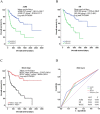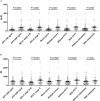Aspartate aminotransferase-lymphocyte ratio index and systemic immune-inflammation index predict overall survival in HBV-related hepatocellular carcinoma patients after transcatheter arterial chemoembolization
- PMID: 26506519
- PMCID: PMC4767493
- DOI: 10.18632/oncotarget.5719
Aspartate aminotransferase-lymphocyte ratio index and systemic immune-inflammation index predict overall survival in HBV-related hepatocellular carcinoma patients after transcatheter arterial chemoembolization
Abstract
It has been suggested that lymphocytes play central roles in host antitumor immune responses and control cancer outcome. We reviewed the clinical parameters of 189 hepatocellular carcinoma (HCC) patients and investigated the prognostic significance of lymphocyte-related scores in HCC patients following transcatheter arterial chemoembolization (TACE). Survival analysis revealed that an elevated aspartate aminotransferase-lymphocyte ratio index (ALRI) > 57 and a systemic immune-inflammation index (SII) > 300 were negatively associated with overall survival in HBV-related HCC (HR = 2.181, P = 0.003 and HR = 2.453, P = 0.003; respectively). Spearman chi-square analysis showed that ALRI had a specificity of 82.4% and that SII index had a sensitivity of 71.9% for HCC overall survival. ALRI and SII had negative predictive values of 74.6% and 80%, respectively for HCC overall survival. Additionally, Barcelona Clinic Liver Cancer (BCLC) stage C patients had significantly higher ALRI and SII scores (both P < 0.0001) and poorer overall survival (HR = 3.618, P < 0.001). Additionally, HCC patients with portal vein tumor thrombosis (PVTT) had higher ALRI and SII scores (P < 0.0001 and P = 0.0059, respectively). In conclusion, as noninvasive, low cost, easily assessable and reproducible parameters, elevated ALRI and SII should be used as negative predictive factors for overall survival in HBV-related HCC in clinical practice.
Keywords: aspartate aminotransferase-lymphocyte ratio index; hepatocellular carcinoma; lymphocyte cell; survival; systemic immune-inflammation index.
Conflict of interest statement
There is no conflict of interest.
Figures


References
-
- Ferlay J, Bray F, Pisani P, Parkin DM. (Cancer Base No.5 Version 2.0) IARCPress; Lyon, France: 2004. GLOBOCAN 2002: Cancer incidence, mortality and prevalence worldwide IARC.
-
- Parkin DM. Global cancer statistics in the year 2000. Lancet Oncol. 2001;2:533–543. - PubMed
-
- Allemani C, Weir HK, Carreira H, Harewood R, Spika D, Wang XS, Bannon F, Ahn JV, Johnson CJ, Bonaventure A, Marcos-Gragera R, Stiller C, Azevedo e Silva G, et al. Global surveillance of cancer survival 1995–2009: analysis of individual data for 25,676,887 patients from 279 population-based registries in 67 countries (CONCORD-2) Lancet. 2015;385:977–1010. - PMC - PubMed
-
- Shariff MI, Cox IJ, Gomaa AI, Khan SA, Gedroyc W, Taylor-Robinson SD. Hepatocellular carcinoma: current trends in worldwide epidemiology, risk factors, diagnosis and therapeutics. Expert Rev Gastroenterol Hepatol. 2009;3:353–367. - PubMed
-
- Siegel R, Naishadham D, Jemal A. Cancer Statistics, 2012. CA Cancer J Clin. 2012;62:10–29. - PubMed
MeSH terms
Substances
LinkOut - more resources
Full Text Sources
Other Literature Sources
Medical
Miscellaneous

